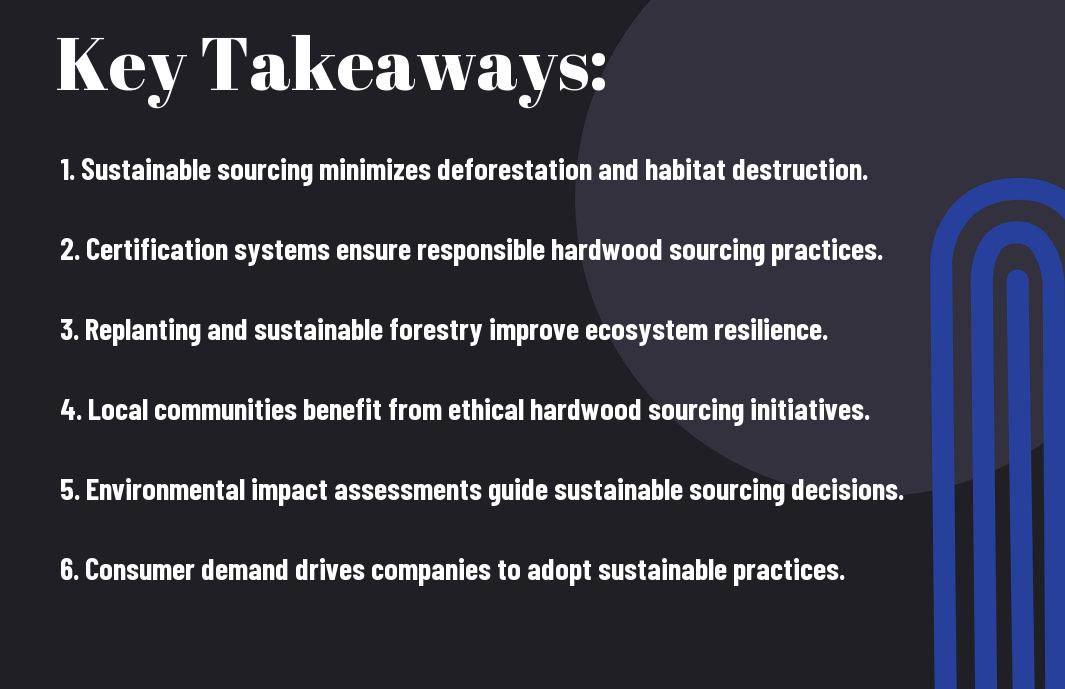Just as demand for hardwood increases, so does the importance of sustainable sourcing practices. You might not realize how your purchasing decisions affect ecosystems and communities around the world. This blog post will examine into the environmental impact of hardwood giants, providing insights into their harvesting practices and the importance of responsible sourcing. By understanding these factors, you can make informed choices that not only enhance your projects but also contribute to a healthier planet.

The Importance of Sustainable Sourcing
To navigate the complexities of sourcing hardwood products responsibly, it is imperative to grasp the significance of sustainable sourcing. This practice involves acquiring wood from forests that are managed in a way that maintains their biodiversity, productivity, and ecological processes. By prioritizing sustainable sourcing, you are not only supporting economic well-being for local communities but also ensuring that resources remain available for future generations. In an era where deforestation and environmental degradation are pressing issues, making informed choices in the sourcing of hardwood is a step towards fostering a healthier planet.
Definition of Sustainable Sourcing
Around the world, sustainable sourcing is defined by a commitment to responsible forestry practices that protect and enhance forest ecosystems. It incorporates methods that reduce negative impacts on the environment while also promoting social equity and economic viability. By understanding the parameters that categorize wood as sustainably sourced, you empower yourself to make purchasing decisions that align with your values and promote conservation efforts.
Benefits for the Environment
An imperative aspect of sustainable sourcing is its myriad benefits for the environment. When you choose sustainably sourced hardwood, you help to combat deforestation, which contributes to climate change and habitat loss. Sustainable practices often involve replanting trees and preserving existing forests, which play a pivotal role in absorbing carbon dioxide from the atmosphere. Moreover, these practices can reduce the risk of soil erosion and improve water quality, ensuring that ecosystems remain healthy and diverse.
Environmentally responsible sourcing acts as a protective measure, not only for the forests from which your materials are derived but also for the overall ecological balance. The trees harvested through sustainable methods contribute to the maintenance of carbon sequestration processes, mitigate pollution, and stabilize local climates. By integrating sustainable sourcing into your purchasing decisions, you are directly participating in the global movement toward environmental stewardship and resource preservation, fostering a healthier atmosphere for all forms of life.

Environmental Impacts of Hardwood Production
Some of the most pressing environmental concerns surrounding hardwood production relate to deforestation and habitat loss. As demand for hardwood products increases, large swathes of forest land are cleared, which can lead to a significant reduction in biodiversity. When trees are cut down for timber, entire ecosystems are disrupted, affecting both animal and plant species that depend on these habitats. As a responsible consumer, you must be aware of how your purchasing choices can contribute to these unfortunate outcomes, as the loss of biodiversity has profound implications not only for wildlife but also for human health and well-being.
Deforestation and Habitat Loss
Any time trees are harvested indiscriminately, detrimental effects on local wildlife and plants can ensue. The interconnectedness of forest ecosystems means that every tree cut down can have a cascading impact on the various species that rely on it for shelter, food, and breeding grounds. You might not immediately associate your hardwood furniture or floorings with the plight of endangered species, but the reality is that unsustainable harvesting practices contribute to habitat degradation and loss. To combat this, you can choose to support brands that prioritize sustainable forestry practices and certification programs.
Carbon Footprint and Climate Change
The connection between hardwood production and climate change is another imperative issue to consider. Deforestation contributes to carbon emissions, as trees absorb carbon dioxide (CO2) from the atmosphere. When trees are felled, the carbon stored in their wood is released back into the atmosphere, exacerbating the greenhouse effect and accelerating climate change. By making informed choices in your hardwood purchases, you can help mitigate these impacts and promote more sustainable practices that benefit both the environment and future generations.
Consequently, you may want to look into hardwood products that come from sustainably managed forests. Certifications such as the Forest Stewardship Council (FSC) indicate that the wood has been sourced responsibly, ensuring that the forest does not suffer unsustainable harvesting. Not only does this help maintain the balance of the ecosystem, but it also minimizes your carbon footprint, making your home or project more environmentally friendly. By considering the sustainability of hardwood before making a purchase, you are directly contributing to a healthier planet and a reduction in climate change-related impacts.
Key Players in the Hardwood Industry
Many individuals and organizations significantly influence the hardwood industry, impacting production, sourcing, and overall sustainability. Understanding these key players can help you navigate the complex landscape of hardwood sourcing effectively. From large manufacturers to smaller, niche companies, each actor in the market brings unique practices and policies, making it vital for you to be aware of who they are and how they contribute to environmental efforts.
Major Hardwood Manufacturers
By recognizing the major hardwood manufacturers, you can make more informed decisions about where to source your materials. These companies often have the largest market shares and can set the standard for production practices within the industry. You will find that leading manufacturers are increasingly adopting sustainable practices due to growing consumer demand for environmentally friendly products. This shift not only influences their reputation but also drives the entire industry toward better sourcing methods.
Certifications and Standards
About the certifications and standards in the hardwood industry, these are vital for promoting sustainable forestry practices. Certifications such as the Forest Stewardship Council (FSC) and the Programme for the Endorsement of Forest Certification (PEFC) help you identify which products are sourced from responsibly managed forests. These standards can be vital for ensuring that your sourcing decisions align with your environmental goals.
But navigating the myriad of certifications can sometimes be overwhelming. Each certification serves different purposes and adheres to various criteria that reflect environmental, social, and economic impacts. When you consider certified hardwood, it not only assures you of sustainable practices but also fosters a sense of responsibility towards maintaining our forests for future generations. Understanding these standards will empower you to choose materials that align with your values while supporting manufacturers committed to sustainability.
Methods for Sustainable Sourcing
After understanding the importance of sustainable sourcing, you might be curious about the methods employed by responsible companies in the hardwood industry. Sustainable sourcing not only ensures that the environment is respected but also promotes ethical practices within the supply chain. By committing to methods like responsible harvesting, reforestation, and ecological restoration, companies can significantly reduce their environmental impact while providing high-quality hardwood products.
Responsible Harvesting Practices
On approaching responsible harvesting practices, you should be aware that these methods prioritize the preservation of ecosystems. Sustainable logging techniques involve selective cutting, which means only specific trees are harvested while leaving others untouched. This approach maintains biodiversity and allows forests to continue thriving. Additionally, employing advanced technology, such as satellite imagery and drones, helps companies monitor their timber harvesting, ensuring that they comply with legal and environmental standards.
Reforestation and Ecological Restoration
Along with responsible harvesting, reforestation and ecological restoration play necessary roles in sustainable sourcing. Companies committed to these practices actively engage in planting new trees to replace those that have been harvested. This not only helps in replenishing forests but also offsets carbon emissions, contributing to a healthier planet. Ecological restoration involves more than just planting; it focuses on rebuilding entire ecosystems to replace those that have been disrupted by unsustainable timber practices.
But it’s important to also recognize how reforestation and ecological restoration benefit local communities. By engaging with community members in these efforts, companies provide job opportunities and education about sustainable land management practices. When you support businesses that prioritize reforestation, you’re not only investing in high-quality hardwood but fostering the health of both the environment and the communities that rely on these ecosystems for their livelihood.
Case Studies in Sustainable Hardwood Sourcing
Not all hardwood sourcing practices lead to environmental degradation. Numerous case studies illustrate how sustainable hardwood sourcing can benefit both the ecosystem and local communities. Below are key examples that provide insights into successful models that can be replicated across the industry:
- 1. The Forest Stewardship Council (FSC): Over 200 million hectares of forest are now certified globally under FSC standards, promoting responsible management and sustainable practices.
- 2. Sustainable Timber Tasmania: This initiative has achieved 100% certification for its hardwood timber operations, exporting around 40,000 cubic meters annually while maintaining a biodiversity focus.
- 3. The Rainforest Alliance: Implemented sustainable practices in 30 countries, positively affecting over 100,000 hectares of forest and engaging more than 1,000 forest management companies.
- 4. The Amazon Rainforest Conservation Project: This project protects over 1 million acres of rainforest while partnering with local communities for sustainable harvesting, creating incomes for over 500 families.
- 5. Sustainable Forest Initiative (SFI): In the U.S. and Canada, SFI has certified over 300 million acres of forestland and engaged with over 2 million acres of trained landowners in sustainable practices.
Successful Initiatives and Partnerships
At the forefront of sustainable hardwood sourcing are successful initiatives that have adopted collaborative approaches and strong partnerships. Organizations like the World Wildlife Fund (WWF) and major timber companies have formed alliances to develop sustainable supply chains. These collaborations focus on transparency, traceability, and certification, allowing consumers to make informed purchasing decisions. Companies involved in such partnerships report reductions in deforestation rates and improved relationships with local stakeholders, ensuring their operations benefit both the environment and local economies.
Lessons Learned from Industry Leaders
To navigate the complexities of sustainable hardwood sourcing, industry leaders have cultivated valuable lessons that can guide your efforts in responsible sourcing. Many of these leaders emphasize the importance of adopting comprehensive sustainability policies and investing in technology that increases supply chain transparency. They encourage a proactive approach toward stakeholder engagement, ensuring that both communities and ecosystems are considered in decision-making processes. By following their strategies, you can contribute to a more sustainable hardwood industry.
Understanding the nuances of sustainable hardwood sourcing allows you to approach this topic with depth and authority. The experiences of industry leaders reveal that commitment to sustainability is not merely a trend but rather a necessary evolution in the hardwood sector. Their insights reflect the importance of continuous education, investment in eco-friendly practices, and the need for robust partnerships, all of which are integral for a more sustainable future in hardwood sourcing.
Consumer Awareness and Responsibility
Now, as a consumer, your awareness and responsibility play a vital role in promoting sustainable sourcing practices within the hardwood industry. By understanding the environmental impact of your purchasing choices, you can contribute to a more sustainable future. Opting for products that are sourced from responsibly managed forests not only aids in preserving biodiversity but also helps combat climate change by reducing deforestation rates. When you make informed decisions, you lead by example and inspire others to consider the origins of the materials they use, ultimately creating a ripple effect toward more sustainable consumption patterns.
The Role of Consumers in Sustainable Choices
One way you can actively engage in sustainable choices is by supporting brands that prioritize responsible sourcing and transparency in their supply chains. Researching and selecting furniture and flooring made from certified sustainable sources, such as those recognized by organizations like the Forest Stewardship Council (FSC), helps ensure your purchases contribute positively to both the economy and the environment. You also have the power to ask retailers about the origins of their products, pushing them to become more accountable and mindful about sustainability.
Advocacy and Education Efforts
Against this backdrop, your advocacy efforts can significantly influence public perception and industry standards. Joining local or international campaigns focused on sustainable forestry can empower your voice to drive change. You can also engage in community education initiatives, spreading awareness about the importance of sustainable sourcing practices among your peers. By participating in workshops or information sessions, you not only enhance your understanding but also contribute to a collective movement pushing for more responsible and informed consumption.
Considering the growing demand for sustainable products, your involvement in advocacy and education can lead to enhanced awareness about the benefits of selecting responsibly sourced hardwood. Opportunities to connect with environmental organizations and participate in community events can provide valuable insights into the hardwood sourcing process. By prioritizing education, you equip yourself and others with the tools necessary to make impactful choices, fostering a culture of mindfulness around hardwood consumption and advocating for sustainable practices in the industry.
Conclusion
Summing up, understanding the environmental impact of hardwood giants is crucial for you as a consumer. By choosing products sourced from sustainable practices, you not only support environmentally responsible companies but also contribute to the preservation of invaluable ecosystems. Your purchasing decisions can encourage more businesses to adopt sustainable sourcing methods, ultimately mitigating the adverse effects of deforestation and promoting biodiversity. It is imperative for you to stay informed about the origin of your hardwood products and the certifications that guarantee their sustainability.
Moreover, as awareness around environmental issues continues to grow, your efforts to prioritize sustainable sourcing in your purchasing habits can drive the market towards better practices. Engaging with brands that prioritize transparency and environmental responsibility empowers you to make choices that align with your values. By advocating for sustainable hardwood sourcing, you play a pivotal role in fostering a healthier planet for future generations while enjoying the beauty and durability of hardwood products responsibly sourced from our forests.





